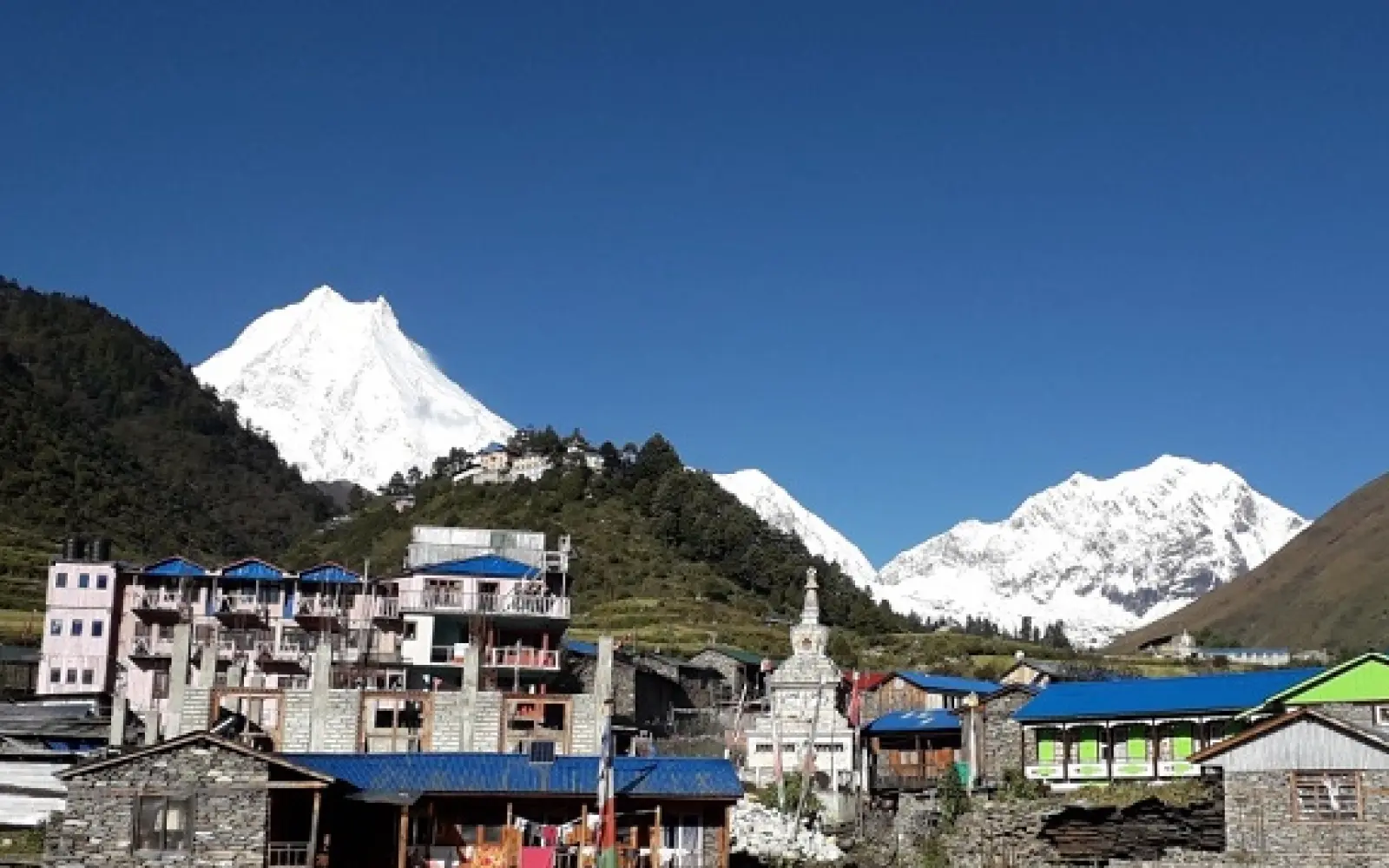Knowledge Networking Portal for Sustainable & Responsible Tourism










 Lho Gaon: A Spiritual Village on Manaslu Circuit Trek
Lho Gaon: A Spiritual Village on Manaslu Circuit Trek

Introduction
Lho-Gaon, or Lho for short, is a charming Himalayan village in Nepal's Manaslu area. It is situated at an altitude of around 3,180 meters above sea level. This peaceful village is a famous overnight stay on theManaslu Circuit Trek. It is located just ahead of Samagaon and is an excellent place to see the mountains, especially Mt. Manaslu (8,163 m). Trekkers spend a night or two here to rest and acclimatize before going higher to Larkya La Pass(5106m).
Actually, the Lho village boasts a highly Tibetan Buddhist culture. There are prayer wheels, mani walls, and chortens surrounding the village. The people of Lho are Tibetans living simple spiritual lives. The surroundings are peaceful and traditionally strong. It is not as busy as the larger villages and is free from modern development.
One of the major highlights of Lho is the large Ribung Monastery. Situated on a hill above the village, it has a panoramic view of Manaslu and other peaks. Monks in red robes chant prayers each morning and evening. Trekkers who are doing often visit the monastery to seek peace and meditation.
In brief, Lho-Gaon is not merely a trekking point. It's a quiet village where nature and culture exist in perfect tandem. For this, many trekkers remember Lho as the highlight of their Manaslu Circuit Trek experience. The landscape, the people, and the silence are long remembered.
Geography and Location
Lho-Gaon is a rural settlement in Gorkha District in Nepal. It is located at 3,180 meters above sea level. The town is along the upper trail of the Manaslu Circuit, midway between Namrung and Samagaon. It lies within the Manaslu Conservation Area. This section of the trail transitions from lower hills to alpine landscape. Because of this transition, Lho offers both forest and high mountain views.
Likewise, the Budhi Gandaki River resumes its flow through the valley below Lho Gaon. In all directions, snow-capped peaks rise upwards. Most prominent is Mt. Manaslu (8,163 m), the eighth-highest peak in Nepal. Trekkers can see this magnificent peak in its entirety from Lho itself. Lho is open and airy, with fewer trees and broader skies than lower-down villages.
Moreover, the surroundings of Lho Gaon include terraced fields, pine forests, and yak pastures. The trail to the village rises gently, with sights of glaciers and hanging cliffs. In spring, rhododendron blooms add color to the hills. The weather is cool and crisp, particularly in the mornings and evenings. Because of its altitude, Lho is often used as an acclimatization stop before climbing higher.
In short, the geography of Lho-Gaon is a great combination of nature's highlights. Trekkers get to experience rivers, forests, monasteries, mountains, and open skies together in a single location. Thus, its location makes it one of the most picturesque and tranquil villages of the Manaslu Circuit trek. Its location gives a full Himalayan experience.
Accessibility
Lho-Gaon is accessible only by walking, as no roads connect to this village. Trekkers normally start from Arughat Bazaar or Soti Khola or Machhakhola (930m). It takes 6 to 8 days of walking from Soti Khola/Machhakhola to arrive at Lho Gaon. The path passes through some noteworthy villages, which include Jagat, Deng, and Namrung. The trail is well marked and follows the Budhi Gandaki River valley.
Unlike lower elevations, trekking to Lho involves steady uphill climbs. The trail passes through pine forest, terraced fields, and rocky landscapes. Suspension bridges over the Budhi Gandaki River are crossed multiple times. Trekkers are exposed to varied terrain, steep slopes, and rough paths. Elevation at Lho is 3,180 meters, and acclimatization during Manaslu Circuit Trek is necessary here before heading towards Dharmasala and Larkya La Pass (5106m).
Meanwhile, weather is a key component of accessibility to Lho Gaon from Machhakhola. The monsoon period from June to September receives heavy rainfall and, at times, landslides. They can delay or close the trail temporarily. Winter days bring snow and cooler temperatures, which can make the trail slippery and difficult. Spring and autumn offer the best period for stable access and clear trails to go to Lho Village and for entire Manaslu Circuit Trek.
Actually, most trekkers hire local guides and porters in lower villages or in Kathmandu to help carry gear and navigate the terrain safely to Lho Gaon. Mobile phone network coverage worsens as trekkers approach Lho. There is limited Wi-Fi in a few tea houses, but signals may be poor. Emergency helicopter rescues are possible but costly and only attempted in dire emergencies.
In brief, Lho-Gaon is reachable only on foot via well managed trails from Machhakhola via Deng and Namrung. Despite challenges like weather and altitude, its accessibility offers a reasonable experience between adventure and safety. Trekkers find the trip to be part of the authentic Himalayan adventure.
Facilities
Lho-Gaon offers basic but essential facilities for trekkers on the Manaslu Circuit Trek. Several tea houses and guesthouses provide simple rooms with wooden beds and warm blankets. Most accommodations have shared bathrooms, often with squat toilets. Unlike lower-altitude villages like Jagat, some lodges in Lho offer hot showers, especially during the trekking season. Heating is usually provided by wood or gas stoves, which help during cold nights.
Moreover, electricity is available here at Lho Gaon but restricted. Many lodges use solar power or small hydropower plants. There is a nominal charge for charging electronic equipment. Wi-Fi is available in a few tea houses, but connections are always weak and unstable. There is sporadic mobile network coverage as the village is located in a remote hilly area. Trekkers appreciate the opportunity to unplug and enjoy the peaceful surroundings.
Likewise, the cuisine in Lho is mostly traditional Nepali and Tibetan. Dal bhat, noodles, vegetable soup, and Tibetan bread are the standard fare. Tea, coffee, and herbal drinks are served throughout the day. Clean drinking water is usually available, but purification is recommended. Snacks, bottled water, and some general trekking equipment are on sale from small shops, but the selection is limited. There is no ATM service in Lho, and trekkers are recommended to bring sufficient cash for their Manaslu Circuit Trekking.
Similarly, medical facilities are very basic with local pharmacies and community health posts. Therefore, trekkers are recommended to carry their own medicines and first-aid kits. In case of emergencies, guides and porters can assist. Lho-Gaon facilities offer a trade-off between comfort and bare mountain living in general. In brief, it is a convenient and welcoming stopover for trekkers acclimatizing for greater heights during Manaslu Circuit Trek.
Lodges in Lho Gaon
- Majestic Manaslu Guest House – Good views, clean rooms, attached bathrooms (limited).
- Tashi Dalek Guest House – Welcoming hosts, simple rooms, good food.
- Namaste Lodge – Peaceful and cozy, ideal for rest after a long trek.
- Lho Hilltop Lodge – Panoramic view of Manaslu, good dining hall.
- Manaslu Lodge – Basic rooms, shared toilets, warm dining hall.
Major Attractions
Lho-Gaon offers several fascinating highlights for trekkers who are on Manaslu Circuit Trek. The village sits at 3,180 meters and boasts stunning Himalayan vistas. Most impressive is Mt. Manaslu (8,163 m), Nepal's eighth-highest peak, which looms large on the horizon. Trekkers enjoy watching the sun rise over Manaslu, as it casts the snow-capped peak in vibrant orange and pink hues. For many, this is a trip highlight.
Likewise, the Lho village itself is rich in Tibetan Buddhist culture. There are mani walls, prayer flags, and chortens along village paths and trails. These religious symbols lend an atmosphere of peace and spirituality. The Ribung Monastery above Lho is an important cultural site. It is a haven for monks who perform daily prayers and rituals. The monastery is typically visited by travelers to experience local peace and spirituality.
Moreover, the nature lovers relish the surroundings of Lho Gaon very much. Actually, the hillsides are blanketed with pine and rhododendron forests. Rhododendron flowers bloom in bright red and pink in the spring. There is Budhi Gandaki River in the valley down below, adding gentle noises to the environment. Birds and small mammals are common sights on nearby trails.
Also, Lho Gaon is the entrance to the popular Nubri Valley. The area provides more secluded trekking trails and more intimate Tibetan cultures. In conclusion, Lho-Gaon's highlights are a mix of breathtaking natural scenery and profound cultural heritage. Thus, it is a must visit place on the Manaslu Circuit Trek. The mixture of mountains, religious sites, and serene nature makes Lho memorable.
Ribung Monastery
Ribung Monastery is a small Buddhist monastery located in the Manaslu region of Nepal. It stands at an elevation of approximately 3,150 meters near Lho village.
Actually, the Ribung monastery is a peaceful spot with great mountain views. It offers beautiful glimpses of Mt. Manaslu (8,163m) and other snow-covered mountains.
Moroever, the monastery holds spiritual importance for the nearby Nubri people. In addition, it follows the Nyingma tradition of Tibetan Buddhism.
Likewise, Ribung Monastery is decorated with fluttering prayer flags and wall paintings that are very old. Villagers and monks visit daily to offer and burn butter lamps.
Similarly, many trekkers on the Manaslu Circuit Trek visit the monastery for a peaceful time. It is located just below the trail that goes up to Samagaon.
Unlike big monasteries in Kathmandu and other locations, Ribung is quiet and less crowded. Therefore, visitors enjoy peace and tranquility of mind when they visit.
In fact, the interior of Ribung Monastery is simple but filled with ancient Buddhist scripts andstatues. Incense and chanting provide the space with a spiritual atmosphere.
As Ribung Monatery close to Lho village, trekkers walk by in the late afternoon. They visit to relax, pray, or take pictures of the sunset on Manaslu.
Actually, monks are friendly and normally talk about the history of the Ribung monastery. They take care of the place and conduct local prayers and rituals.
In short, Ribung Monastery is a hidden gem of the Manaslu region in Lho Gaon. Its peacefulness and spiritual intensity offer an out-of-the-world experience at 3,150 meters.
Major Activities to Do
The main activity to do in Lho-Gaon is trekking. The village, located at 3,180 meters, is a key resting place on the Manaslu Circuit Trek. Trekkers overnight here to acclimatize before they head towards higher altitudes like Samagaon. The trail from Namrung to Lho is scenic, passing through pine forests, terraced farms, and rocky hills. Because of its altitude, Lho offers a perfect blend of challenge and relaxation.
Apart from trekking, travelers indulge in nature walks around and near Lho. Treks pass through pine and rhododendron forests that are verdant. Rhododendrons burst into bright red and pink blossoms in spring, making the scenery exquisite. Bird watching is a favored activity since numerous Himalayan birds call the place home. The Budhi Gandaki River valley close by offers serene places to relax and take photographs. Compared to other more crowded trekking destinations, Lho is peaceful and less commercial, enabling travelers to relish in serenity.
Moreover, cultural experiences also enrich a trip to Lho-Gaon. Trekkers often go to the Ribung Monastery, perched on a hill above the village. Monks perform daily prayers and rituals, giving it a spiritual aura. Mani walls, prayer flags, and Buddhist chortens dot the village, attesting to its rich Tibetan Buddhist tradition. The Gurung and Tibetan locals are hospitable and friendly towards tourists. It is rewarding to know their customs, traditions, and festivals. Some trekkers hire local porters or guides here to make their trek easier.
Briefly, Lho Gaon offers a combination of nature, trekking, and culture. This suits both culture lovers and adventure seekers. Therefore, Lho-Gaon is a memorable and must-visit place on the Manaslu Circuit Trek.
Why Is Lho Village Popular?
Lho-Gaon is popular for several reasons and is thus an important stop on the Manaslu Circuit Trek. Firstly, being at 3,180 meters, it provides trekkers with an ideal acclimatization spot during Manaslu Circuit Trek. This allows hikers to safely get used to the higher altitudes. Compared to lower villages, Lho also gives travelers fresh mountain air and spectacular views of Mt. Manaslu (8,163 m). The opportunity to rest here prior to more challenging ascents draws a lot of tourists.
Secondly, Lho is loved for its rich cultural heritage. The village has deep Tibetan Buddhist influences. Mani walls, prayer flags, and chortens are scattered around. The famous Ribung Monastery overlooks the village, providing spiritual guidance and peaceful atmosphere. Trekkers often visit the monastery to observe prayer and rituals. This raw culture beckons tourists interested in spirituality and local life.
Additionally, Lho is endowed with natural beauty. The village itself is picturesque all year round, being surrounded by pine and rhododendron forests. Spring is the season for vibrant rhododendron flowers. The nearby Budhi Gandagi River provides a serene ambiance. Panoramic vistas of Himalchuli (7,893 m) and Shringi Himal (7,161 m) are a trekkers' treat. Lho is less crowded and commercialized compared to other trekking spots and hence maintains its serene ambiance, attracting many.
Briefly, Lho-Gaon is a favorite village along Manaslu Circuit Trek due to its strategic location, fascinating culture, and breathtaking nature. Therefore, it is an excellent destination to explore on the Manaslu Circuit Trek. Lho lingers in the minds of numerous trekkers due to its serene environment and indelible mountain vistas. Overall, the village Lho offers an excellent mix of adventure and relaxation.
Note: This article originally appeared on the Haven Holidays Nepal Blog and has been republished here with permission..
About Haven Holidays Nepal: Haven Holidays is a locally based trekking company in Kathmandu, offering tailor-made adventures to Nepal’s most iconic destinations including Annapurna Base Camp, Everest Region, Manaslu Circuit, and Langtang Valley. Visit us at www.havenholidaysnepal.com
| Concerned URL | https://www.havenholidaysnepal.com/blogs/lho-gaon-a-spiritual-village-on-manaslu-circuit-trek |
|---|---|
| Address | |
| Source | https://www.havenholidaysnepal.com/blogs/lho-gaon-a-spiritual-village-on-manaslu-circuit-trek |
| Keywords | Lho Gaon, Lho village Nepal, Manaslu Circuit Trek, Ribung Monastery, Tibetan culture Nepal, Spiritual villages Nepal, Trekking in Manaslu, Lho to Samagaon, Himalayan villages, Nepal trekking route |
| Target group(s) | Destinations , Businesses , Travellers , Education, Research, Consultancy |
| Topics | Natural Heritage & Biodiversity , Travel, Transport & Mobility , Value Chain Management & Fair Trade |















































